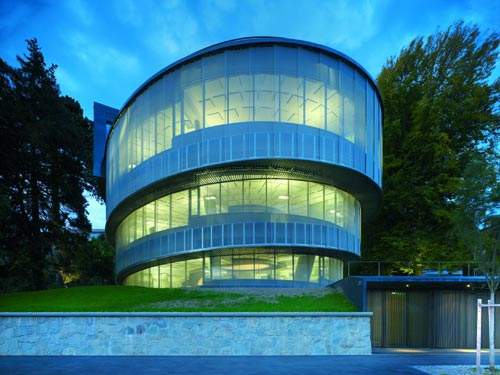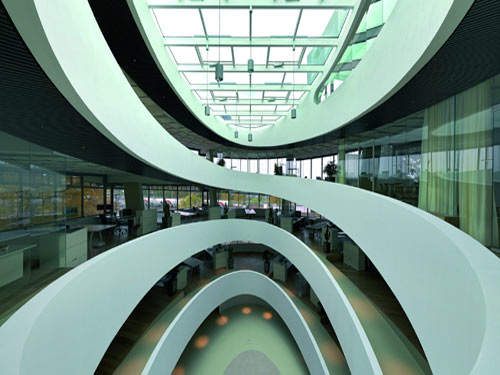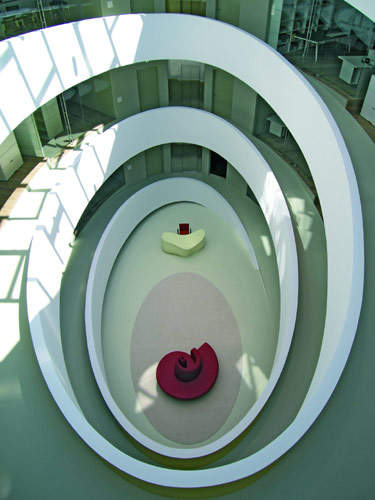Cocoon is situated in the Seefeld district of Zurich in Switzerland. It matches the landscape surroundings and enjoys excellent lake and mountain views. It is surrounded by old trees on three sides and opens up towards the south side overlooking the lake. The elliptical-shaped building spirals beautifully from the green surroundings.
The Cocoon was designed by Camenzind Evolution and is owned by Swiss Life. Construction started in February 2006 and was completed in September 2007.
The building won the RIBA International award in 2009. It was shortlisted at the World Architecture Festival Award 2008, Contract World Award 2009, AR Awards 2008 and LEAF Awards 2008.
Cocoon concept
The Cocoon is an innovative spatial structure, rising upward in a series of stepped levels. Instead of the standard horizontal levels, the Cocoon incorporates a series of elliptical segmented stepped levels. The majority of the levels are arranged adjacent to a gentle ramp that surrounds the naturally lit atrium.
The concept creates a unique workspace that allows free communication and renders a three-dimensional look to the building. The ramp like arrangement of the floor space makes it flexible for future expansions and alterations to suit the changing needs of the occupants. There are flexible partitions on all levels.
The top floor has a glass front that provides a panoramic outside view. Two additional floors include a roof terrace and end the series of stepped levels.
Spiral centrepiece
The naturally lit atrium forms the core of the building’s interior. The ramp rises from the atrium and, with each spiral rotation, expands in size illuminating the entire building. It comprises eight segments that rise 40cm as it moves to the next level. The atrium creates a natural ambience for communication and provides a sense of community for the occupants.
Structure
The building is an earthquake safety reinforced steel concrete construction, which required the submission of a three-dimensional model created using the Finite-Elements-Programme.
The structure is supported by the central service core structure at the back and six outward tilting pillars, inclined at angles of 94°, 98° and 105°, which penetrate the ceiling beams and serve as support for their respective ceiling slabs.
The main entrance to the building, which provides direct access to the atrium, is made of concrete and stone wall. There are 25 segmented levels providing an office space of 1360m2. An elevator and stairwell connects the building from the back.
Façade
The design is based on a multilayered concept. The façade is enveloped like a veil by a stainless steel mesh. The steel curtain slowly moves upwards and is defined by gentle lines; it flows out at the roof in an open frame.
The stainless steel mesh provides privacy and creates a subtle elegance while rendering a distinctive identity to the building. During the day it appears introverted and in the night transforms into a shining transparent structure.
Sustainability
The presence of glass walls and big windows not only establishes visual connection with the outside but also saves electricity by reducing the need for artificial lights. An air-source heat pump system provides the heating and cooling for the building.










